| When the road tunnel was opened in 1996 the original
road over the gap was returned to nature emulating what would have been the
state when the first emigrants crossed in the mid 1700s. It was called a cycle track on the
map but I have to say this was a mountain bike track and was hard going to
us. We did find a lot of wildflowers and butterflies along the way. They
were large but still very hard to get close enough to to photograph. | 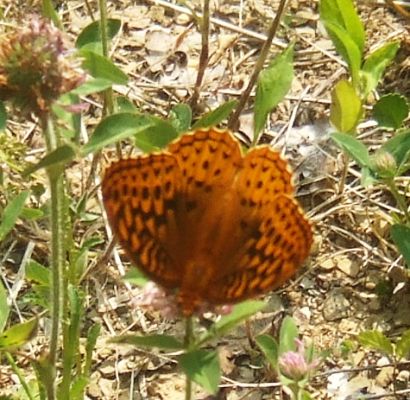 |
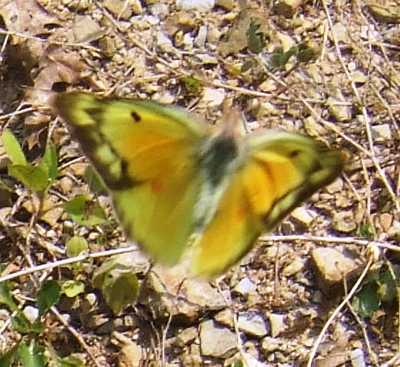 |
There were lots of these with a brilliant yellow coloration but they just
never stopped moving. |
| The flowers were easier to photograph but the path was
quite overgrown. I don't think many people walk or cycle it these days. The
path was poorly marked from the campsite and we had quite a job finding the
beginning. | 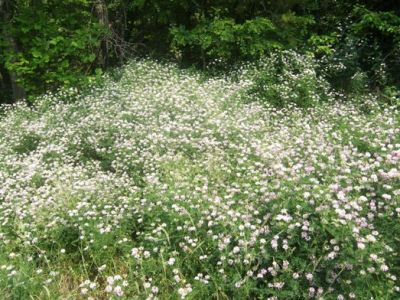 |
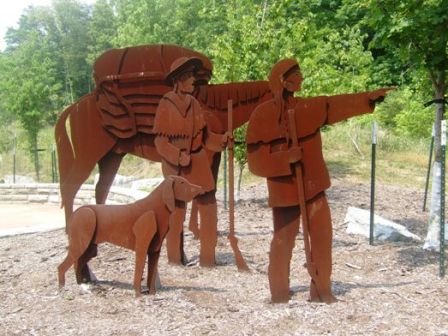 |
We travelled along the way and found a car park and information centre near
Cumberland Gap township. These statues are just steel plates surrounding a
covered area in which they play the sounds of the people travelling with
their carts, horses, oxen and dogs. But uphill they mostly walked. |
| Cycling down the road we passed this turtle crossing
the road. It reminded us of last year when we ran over lots on a road not far
from here which was just covered in turtles. They move very slowly and stop when
startled. They are very colourful with more red than shows in the photo. | 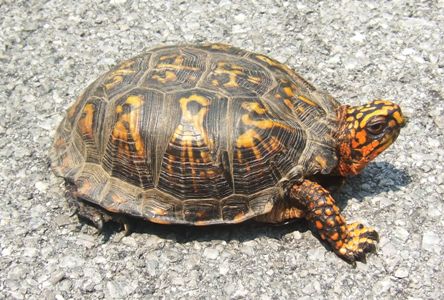 |
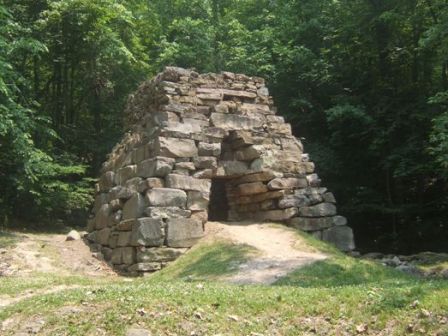 |
In Cumberland Gap are the remains of the old Newlee iron furnace alongside
the river which would have been used to power a bellows. The ore would have
been smelted with wood in this area. It was in use from the
1820s to 1880s. Every day they used 625 bushels of charcoal, 6.25
tons of iron ore and 1563 lbs limestone to make 3 tons of iron in 150lb
ingots. These would have been used locally or shipped down the Powell river
to Chattanooga. |
| In order to protect the fragile track, bicycles were
not allowed beyond the Gap car park. But the old disused railway line which
runs across this covered bridge has been surfaced and turned into a cycle
track to Harrogate. It was not clearly marked but we
managed to find the way. | 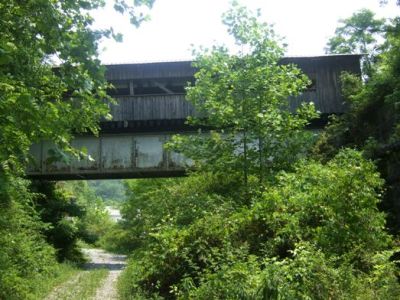 |
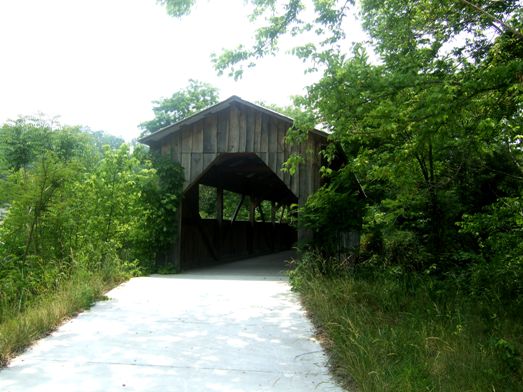 |
There are a number of covered bridges in different parts of the country. The
most famous are probably those in Madison County, Iowa because of the film, but we have found some in
other parts. I think this one had been refurbished. |
| The track also makes use of a tunnel which runs under
the interstate interchange and part of the new tunnel. It does have some lighting and was
a joy to cycle because it was cool in comparison to the heat of the day
outside. | 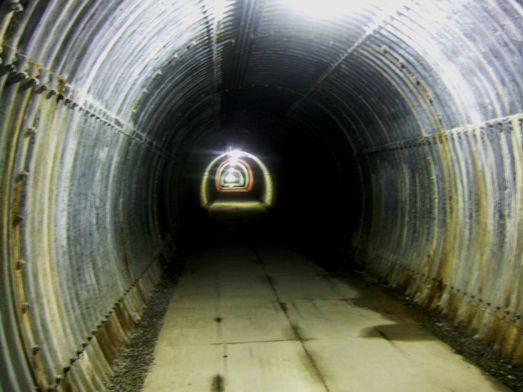 |
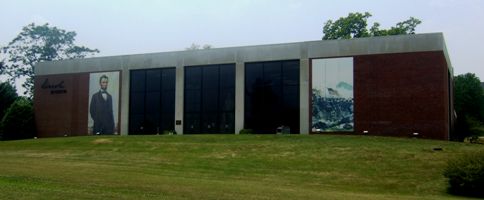 |
On one side of the interstate is the city of Harrogate, on the other side is
the Lincoln Memorial University, a small regional college. Lincoln had
wanted to help the people of the area after the ravages of the Civil War,
but he was assassinated before he could do anything. We had seen Harrow
school in Cumberland Gap which was a precursor of LMU from 1890-1907 in the basement of the
Congregational church. It now also houses a
museum dedicated to Abraham Lincoln and contains many original papers and
artefacts associated with him. |
| There were many statues of Lincoln including some in
groups like this one made by a sculptor called John Rogers ca 1868. The
others in the group are Edwin M Stanton (secretary of war) and Lieutenant
General Ulysses Grant at a meeting in 1864. They are discussing plans for
the general advance against Confederate forces. In those days a copy of this
group would have cost $15. | 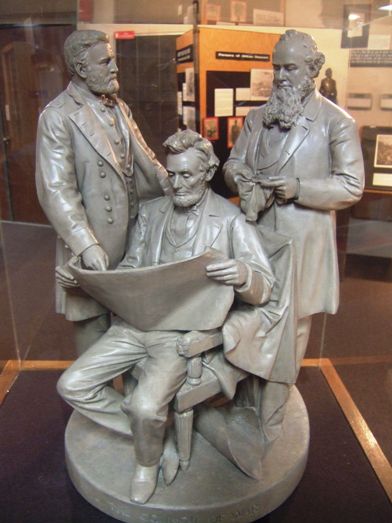 |
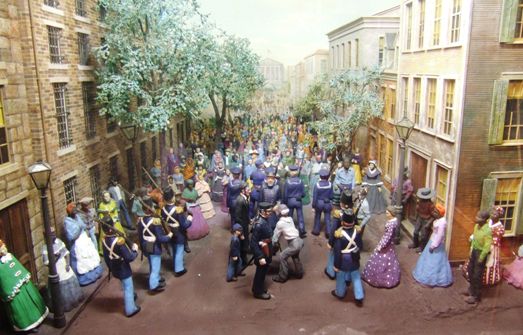 |
The museum also displays many items from the Civil War, including some soldiers' bibles marked
as issued for the use of the army of Oliver Cromwell! There are
several dioramas, this one showing the town of Richmond VA under occupation
during this period. |
| This is the plaster scale model made by sculptor
Daniel Chester French in 1914 as a prototype for the Lincoln memorial in
Washington. The eventual sculpture was 19ft high and made from Georgia
limestone. | 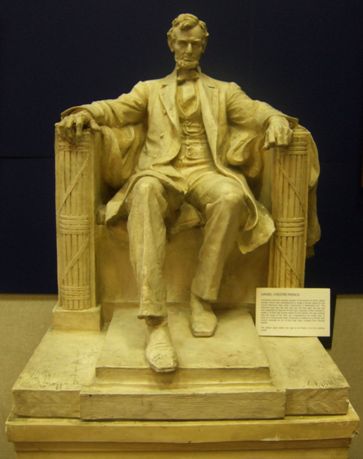 |
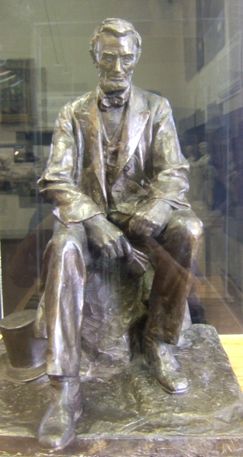 |
This is a later casting and shows him as he is most remembered. Abraham
Lincoln never visited Tennessee although his grandfather after whom he was
named did travel through the Cumberland Gap from Virginia en route to
Indiana and Illinois where Lincoln grew up. |
| This is another popular sculpture showing Lincoln as a
young man with the wood axe, bible and faithful hound thus epitomising the
American virtues of independence, self reliance,
hard work and adherence to the good word. | 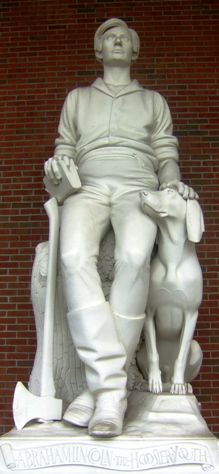 |
 |
And so we travelled on through the new Cumberland Gap Tunnel which is approx 1.4
miles long. When the original 2.8 mile paved road was built in 1908, there
were only 680 miles of paved roads in America. |
| It was a well constructed set of tunnels (there are
three, one as a pilot, and two road tunnels). They link the city of
Harrogate (pop 1600) to the city of Middlesboro (pop 6000) In contrast
their namesakes in England are both only towns with populations of 65000 and 160000
respectively. It helps us understand why Toronto is sometimes called a
'village'. | 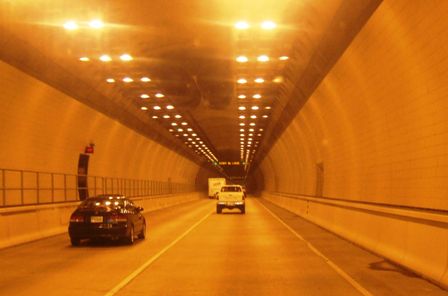 |
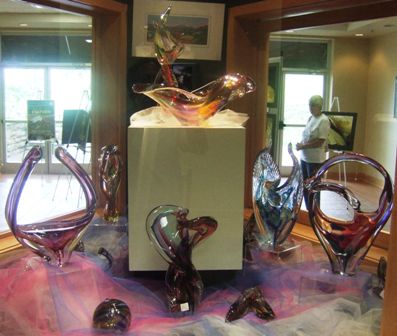 |
Both Middlesboro (originally spelt Middlesborough) KY and Harrogate TN came into being in the 1890s as a
product of land speculation and Alexander (1846-1912) and Nellie Arthur's
dream to build an industrial centre. He was a mining prospector and
entrepreneur who found coal and iron ore and founded some major businesses
to capitalise on them. He was instrumental in the development of the area
although it never quite realised the potential he felt it had. Today we
would probably class it as a scam since building land here was being sold at
prices to rival those in Manhattan - over $400 a frontage foot.
They built their own house called Craig Neuk on a 10 acre plot in the more
fashionable Harrogate. Eventually the bubble burst and a number of people
went bankrupt. Today these communities still live in hope that they will grow and become
prosperous. The Cumberland Gap main visitor centre has a shop selling
beautiful craft work. Jan had to stop and admire this display of glasswork
is just outside. |
|